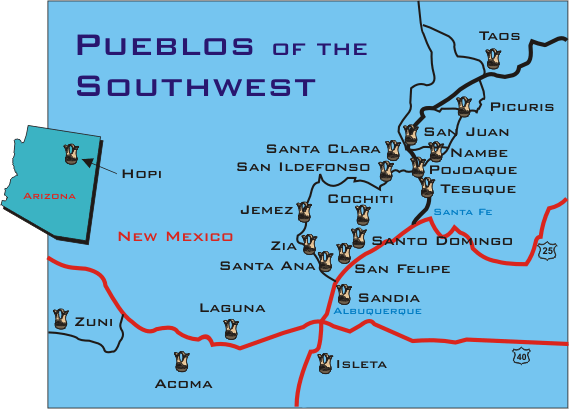 ClayHound Web
- Cochiti Pueblo
ClayHound Web
- Cochiti PuebloReturn to:
|
Cochiti Pueblo Pottery |
|
|
|
|
|
|
|
|
Cochiti Pueblo is located in north-central New Mexico. Santo Domingo and Cochiti pueblos are the most northeastern of the Keresan language villages. They lie just to the south of Tewa villages and accordingly have felt strong ceramic influences from those neighbors. After the Indian revolt of 1680 this influence became especially strong. Both Santo Domingo and Cochiti discontinued their manufacture of glazeware. For awhile they imported pottery from their Puname (early Zia) and Tewa area, and then gradually these pueblos began to make their own copes of the Tewa styles, using carbon paint for the Tewa-like decorations. The classic type of Tewa-like pottery at Santo Domingo and Cochiti bars the Kiua Polychrome. Kiua is the Indian name for Santo Domingo, and the type was made there principally in the period from 1760 to the present. At Cochiti also the type began about 1760 but by 1830 showed signs of evolving into a different one. By 1850 the style was so distinct that we give it the name Cochiti Polychrome. The pottery type known as Cochiti Polychrome developed out of nearly one hundred years of the Kiua Polychrome tradition. By 1850 certain definitive Cochiti characteristics were discernible, principally in design. Cochiti motifs are isolated decorations, often with little relation to one another. The lines are finer than on Kiua Polychrome, giving the motifs a lighter, fussier appearance. A typical Cochiti feature is the habit of embellishing the encircling framing lines with pendant figures, usually simple arcs or triangles, but sometimes enigmatic, complicated adaptations of older feather motifs. |
|
|
The Cochiti are a Keresan tribe and pueblo located thirty miles south of Santa Fe, New Mexico. Each Cochiti person belongs to a clan, inheriting membership in the same clan as his or her mother. In spite of Spanish and American contact, the cultural traditions of the Cochiti are still very strong. The traditional style of government still exists, religious ceremonies are performed by various secret societies and the Cochiti language is still spoken. Crafts of the Cochiti include drums, pottery, basketry and shell and turquoise ornaments. The design on Cochiti pottery is often widespread leaving large areas of white slip in between black motifs. Pottery is made following traditional methods which reflects a general adherence to cultural traditions by the Cochiti that has allowed them to preserve their culture. Early Cochiti pottery was one of two types, Kiva and Cochiti Polychrome, painted with red and black on cream. The various designs included birds, animals and symbols suggesting rain in the form of clouds and lightning. |
|
|
This pueblo has no taboo against representing symbols of fertility on their pottery, such as clouds, rain and lightning, as other pueblos do. There are also fantastic birds, human and animal forms scattered at random over the cream surface, using line drawings. Designs usually include a "spirit break", a break in decorative lines going around the pot which metaphorically releases the spirit of the potter. Since 1900 Cochiti potters have found a ready market for animal figurines and they are particularly known for their owls. Cochiti potters are also known for the ceramic storyteller figurines, originally created by Helen Cordero. These are painted with traditional paints of black and red on cream and consist of a mother surrounded by several children. Contemporary Cochiti ceramic animal figurines and storyteller figures are popular with tourists. from - http://www.cmnh.org/collections/cultural/pueblo-pottery/cochiti.html |
|





